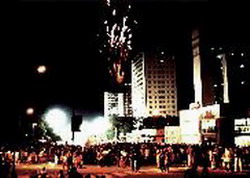Still alive traditions of Santiago de Cuba Carnival
- Submitted by: admin
- Travel and Tourism
- Arts and Culture
- Dance
- Music
- Santiago de Cuba
- 07 / 21 / 2007

Following the rhythm of a refrain the entire people of Santiago de Cuba will also roll from this Saturday 21st to July 27th during the celebration of Santiago carnival; however, the name of the conga has not been for a long time that of The Children of the Cocoyé to adopt, as its usual in Santiago de Cuba, the name of the neighborhood where it was created and where almost all its members live. Besides the conga of Los Hoyos has been an emblematic feature of this party of every July.
Cubans and especially those from Santiago de Cuba like carnivals, the sprees, charangas or other kinds of invitation, but they choose to enjoy this show, its like paying tribute to the tradition and its like eating some autochthonous dish. The alcoholic beverages luckily are not the most wanted. In Santiago de Cuba the people dance next to the musicians of a procession, in short Cubans are born party-goers.
The grandmother is an example chasing after the Chinese bugle, leaving behind even her slippers, to join the human crowd that rolled by in the recent carnivals of Santiago de Cuba. The lawyer-to-be who didn't hesitate to admit to this reporter that carnivals are for him something sacred. Or the boy who impatiently waits for the stars to come down the streets of Trocha, Marti or San Pedro in search of a refreshing beer.
This was confirmed because for many years the carnival of Santiago welcomes the countrymen from all provinces of the country. Our journalistic vision promises that this popular party in the last five years, disregarding sex, occupation or age has become something unexpected for the city inhabitants. The carnivals, of course, symbolize the feeling of Santiago inhabitants; they put together other party traditions deep rooted in the island.
"Carnivals are like air and food for the true sons of Santiago", asserts the mechanic Jorge Sagarra, fan of the conga almost since he was born, in this village.
Who will fight back the calling of the feet, hips, shoulders, the entire body, when the rumba enters through the ears? Ask any Cuban. Not wonder dancing repeatedly appears as one of the recreational preferred options in all ages.
Among flags, banners, the "caperos" spin like tops. Then the dancers, moving their bodies restlessly, to the sound of drums and later follow the conga. There is a crowd that forgets whats human or divine at the strident calling of the Chinese bugle. "Losing the pace is the only sin, everything else is allowed.
If there was any doubt, the question on what is the most wanted show of their Huge Party, like they call it, is now erased. Dancing was move to a second place, only surpassed by the liking to autochthonous traditions, mentioned by half of those interviewed, among those that mentioned the unavoidable Chinese bugle, the walks and processions and the top event, to march behind their favorite conga, feature that today distinguishes the restless Santiago de Cuba and reflects that the carnival of Santiago de Cuba still lives on traditions.
Source: By Alexis Castañeda, Cubarte
Comments